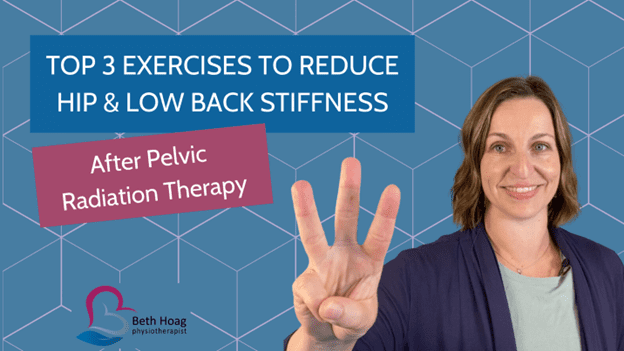In this blog, we’re going to talk about hip and low back stiffness following radiation therapy of the pelvis. Specifically, we’ll cover:
- Common symptoms of hip and low back stiffness after pelvic radiation, and
- Why stiffness and pain occur in the hip and low back
Types of Radiation Therapy for Pelvic Cancers
There are two main ways that radiation therapy can be delivered to the pelvis: internal beam and external beam radiation. Depending on your individual situation you may have only one type of radiation or you may have a combination of both.
- External beam radiation is when radiation therapy is delivered from a machine outside the body that typically moves around the body as you stay still in a specific position.
- Internal beam radiation, also known as brachytherapy, is when radiation is delivered from the inside of the body. There are different ways this can be accomplished, but in the case of pelvic cancers, the two most common application methods are the use of an applicator (usually through the rectum or the vagina) or seeds/pellet insertion.
Each type of radiation therapy has its own specific side effects, both short-term and long-term. In the case of hip and low back stiffness, this is most common after external beam radiation but can still occur after internal beam radiation.
Long-Term Radiation Therapy Side Effects: They Get Missed
In my experience working in cancer rehab, people seem to be relatively aware of and prepared for the short-term skin and tissue irritation that happens near the end of and in the 2-3 weeks following radiation therapy. People have typically been given medical advice about how to manage redness, heat, swelling, mild chafing, and blistering. (Though many are still surprised by the intense fatigue that can happen during radiation…we’ll leave that for another blog!)
In contrast, it’s the longer-term side effects of radiation that most people are not well prepared for or actually have no idea that they can even occur. These group of symptoms typically only begin to show up weeks or even months after radiation therapy is complete. In the case of pelvic radiation therapy, stiffness and pain in the hips and low back can really confuse people and create concern that “something bigger” is going on.
Hip and Low Back Stiffness: What It Might Feel Like
These rarely discussed side effects come on slowly and gradually. By the time these symptoms develop, some people have already been discharged by their radiation oncologist (which poses a challenge for them understanding that these symptoms can happen after radiation therapy to the pelvis!) As a result, the link between pelvic radiation therapy and hip and low back stiffness may be missed, leaving you to live with this for a long time with a significant impact to your quality of life.
If you are experiencing any of the following, you may be experiencing this longer-term side effect of pelvic radiation therapy:
Onset of symptoms: This usually shows up months after radiation is complete, often 4 – 12+ months after the end of radiation.
What you might feel: Though a gradual onset of stiffness in the hips and/or low back is common, many people are good at “ignoring this.” It is my experience that people really start to pay attention when they either start to have pain or when their function begins to suffer. Specifically, you may notice difficulty:
- Crossing your legs in sitting
- Putting on your socks or shoes
- Sitting on the floor (with the kids)
- Standing up after prolonged sitting
Hip and Low Back Pain After Pelvic Radiation Can be Stressful
Over time, this stiffness can progress to pain. Pain after you’ve had a cancer diagnosis (I probably don’t have to tell you), can be extremely distressing.
It’s my experience that, the moment people start to feel pain (especially if it’s near the area of their original cancer site) they become very worried that it might be the cancer “coming back.” Though it’s more likely that these symptoms are due to long-term radiation side effects, it’s still very important for you to speak with your medical provider to discuss these changes in more detail.
There is Hope!

Once “the scary stuff” has been ruled out, it is not uncommon that I hear clients tell me that they’ve been told “this is your new normal”, or “you just have to get used to it”, or “this is just the reality after radiation.” Though I truly believe that the intention behind these words is in an attempt to ease people’s minds, these words unfortunately leave many feeling invalidated and alone.
But please know that you are NOT alone and that there ARE things we can do to improve things.
Though we can’t undo all the side effects of pelvic radiation therapy, we absolutely can improve how you feel with some simple strategies. In my next blog, we’ll go over some things you can do to start feeling better right away.
Key Takeaways: People who have undergone pelvic radiation therapy for cancer treatment may develop progressive stiffness and pain in the hip and low back months after treatment.
- This is caused by tissue healing and fibrosis that continues for months or years after radiation, gradually restricting movement in the hip and low back.
- It is possible to improve this and you are not alone. Read my next blog on reducing your hip and low back stiffness.
Disclaimer – These blogs are for general information purposes only. Medical information changes daily, so information contained within these blogs may become outdated over time. In addition, please be aware that the information contained in these blogs is not intended as a substitute for medical advice or treatment and you should always consult a licensed health care professional for advice specific to your treatment or condition. Any reliance you place on this information is therefore strictly at your own risk.





